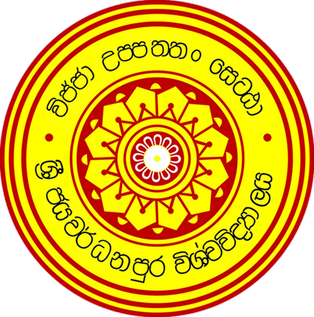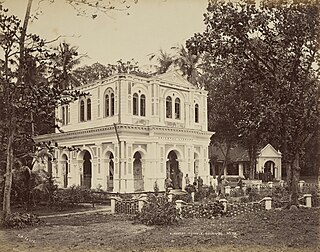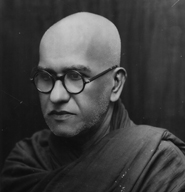Related Research Articles

Balangoda Ananda Maitreya Thero (Sinhala: අග්ග මහා පණ්ඩිත බලංගොඩ ආනන්ද මෛත්රෙය මහා නා හිමි;23 August 1896 – 18 July 1998; was a Sri Lankan Buddhist monk who was one of the most distinguished scholars and expositors of Theravada Buddhism in the twentieth century. He was highly respected by Sri Lankan Buddhists, who believed that he had achieved a higher level of spiritual development. Sri Lankan Buddhists also considered Balangoda Ananda Maitreya Thero as a Bodhisattva, who will attain Buddhahood in a future life.
Walpola Rahula Thero (1907–1997) was a Sri Lankan Buddhist monk, scholar and writer. In 1964, he became the Professor of History and Religions at Northwestern University, thus becoming the first bhikkhu to hold a professorial chair in the Western world. He also once held the position of Vice-Chancellor at the then Vidyodaya University. He has written extensively about Buddhism in English, French and Sinhala. He wrote the book What the Buddha Taught about Theravada Buddhism.

The University of Kelaniya(Sinhala: කැලණිය විශ්වවිද්යාලය, Tamil: களனி பல்கலைக்கழகம், abbreviated UoK) is a state university in Sri Lanka. Just outside the municipal limits of Colombo, in the city of Kelaniya, the university has two major institutions and seven faculties.
The Buddhist monastic education system facilitates basic educational needs of the Asian Buddhist countries before the contemporary era. Learning traditions can be traced back to ancient India where learning began with educated monastics, teaching younger monks and the lay people. The monastic instruction was based on Buddhist value system and emphasized that learning was an end in itself, one that is "worth a strenuous pursuit to possess for its own sake" and that "teaching was for ends that were above mere gain".
The Sixth Buddhist Council was a general council of Theravāda Buddhism, held in a specially built Mahā Pāsāṇa Guhā and pagoda complex at Kaba Aye Pagoda in Yangon, Burma. The council was attended by 2500 monastics from eight Theravādin Buddhist countries. The Council lasted from Vesak (Visākha) 1954 to Vesak 1956, its completion coinciding with the traditional 2500th anniversary of the Gautama Buddha's Parinibbāna. In the tradition of past Buddhist councils, a major purpose of the Sixth Council was to preserve the Buddha's teachings and practices as understood in the Theravadin tradition.

The University of Sri Jayewardenepura is a public university in Sri Lanka. It is in Gangodawila, Nugegoda, near Sri Jayewardenepura Kotte, the capital city. It was formed in 1958 out of the Vidyodaya Pirivena, a Buddhist educational centre which was founded in 1873 by Ven. Hikkaduwe Sri Sumangala Thera.
The University of Sri Lanka was the public university system of Sri Lanka from 1972 to 1978.

The Buddhist and Pali University of Sri Lanka is a Buddhist university in Homagama, Sri Lanka. It was founded in 1981 and is organized in two faculties.

Venerable Mapalagama Wipulasara Maha Thera was a Theravada Buddhist monk in Sri Lanka. He was also an artist and sculptor who has gained fame through his sculptures of Buddha statues that are worshiped in many places within Sri Lanka and abroad. He has held Exhibitions in Soviet Russia and China in the years 1961 and 1963 respectively.
Parâkramabâhu VI (1410/1412/1415–1467) was a king in the Sri Lankan kingdom of Kotte. He is the last great king in Sri Lanka who managed to unite the island under one flag. His rule is famous for the political stability which he maintained in that time period and the thriving of literature, especially poetry. Classical literature as well as many rock inscriptions and royal grant letters have been found, rendering much information pertaining to this period.

The Buddhist Institute is the principal Buddhist institution of the government of Cambodia.

The Sanam Luang National Dhamma Studies Examination Curriculum is a three tier system used throughout Thailand for training in theoretical knowledge about Buddhism. The curriculum is run in tandem with the nine-tiered Pahrian Thamm curriculum for Pali Studies. The curriculum offers two slightly different sets of examination papers
- Nak Thamm designed for the ordained Sangha i.e. Buddhist monks, novices and nuns)
- Thammaseuksa designed for lay Buddhists.

The Vidyodaya Pirivena was one of the prominent piriven in Sri Lanka. It was founded in 1873 by Ven. Hikkaduwe Sri Sumangala Thera and later in 1959, the pirivena was granted the university status by the Government of Sri Lanka.

Witiyala Seewalie Thera is the founder and chief incumbent priest of Minnesota Buddhist Vihara. Currently, he is serving the Buddhist spiritual needs for people in six midwestern states: Minnesota, Wisconsin, South Dakota, North Dakota, Iowa and Nebraska.

Bodagama Chandima thero was born on 3 February 1957 in Thanamalwila, Sri Lanka. As of 2015 he taught Theravada Buddhism in Taiwan. With a group of Taiwanese Buddhists, he founded the Theravada Samadhi Education Association in Taipei.

Hikkaduwe Sri Sumangala Thera was a Sri Lankan Buddhist monk, who was one of the pioneers of Sri Lankan Buddhist revivalist movement in the 19th century. He did a great service to improve the Buddhist Education in the country and was the founder of Vidyodaya Pirivena, Maligakanda in 1873 which was granted the university status later in 1959 by the Government of Sri Lanka. A veteran author and a fiery orator, he was a major figure in the Panadurawadaya, a religious debate held between Christian missionaries and Buddhist monks in 1873 at Panadura, Sri Lanka. He was well versed in Sinhala, Pali, Sanskrit, English, Buddhism, History, Arithmetic, and Archaeology and was one of the primary sources of information on Buddhism for the success of the Panadura debate.

Ratmalane Sri Dharmaloka Thera was a scholar Buddhist monk who lived in the 19th century in Sri Lanka. An educationist and revivalist of Sri Lankan Buddhism, he was reputed for his knowledge of Pali, Sanskrit and Buddhist Philosophy. Ratmalane Sri Dharmaloka Thera was the founder of Vidyalankara Pirivena, Peliyagoda, which was granted the University status later by the Sri Lankan government in 1959, and presently known as University of Kelaniya. Sri Dharmaloka College in Kelaniya, Sri Lanka is named after him.

Palane Vajiragnana Thero was a Sri Lankan (Sinhala) scholar Buddhist monk, who founded the Siri Vajiraramaya temple in Bambalapitiya, Sri Lanka. He was also the Maha Nayaka (head) of Amarapura Sri Dharmarakshita sect for 37 years from August 5, 1918 until his death in 1955.

Monastic examinations comprise the annual examination system used in Myanmar (Burma) to rank and qualify members of the Buddhist sangha, or community of Buddhist monks. The institution of monastic examinations first began in 1648 during pre-colonial era, and the legacy continues today, with modern-day examinations largely conducted by the Ministry of Religious Affairs's Department of Religious Affairs.
Sri Lankan Forest Monks' Tradition claims a long history. As the oldest Theravada Buddhist country in the world, several forest traditions and lineages had been existed, disappeared and re-emerged circularly in Sri Lanka. The current forest traditions and lineages in Sri Lanka have been influenced by the Burmese and Thai traditions which descend from the ancient Indian and Sri Lankan traditions.
References
- ↑ "Annual Report 2017" (PDF). Ministry of Finance, Sri Lanka. Retrieved 13 Sep 2018.
- ↑ "The Evolution of Education in Sri Lanka". roar.media. Retrieved 2018-12-19.
- 1 2 3 4 5 "The Pirivena System of Buddhist Education in Sri Lanka | Buddhistdoor". www.buddhistdoor.net. Retrieved 2018-12-19.
- ↑ "The Pirivena System of Buddhist Education in Sri Lanka | Buddhistdoor". www.buddhistdoor.net. Retrieved 2018-12-19.
- ↑ "The Pirivena System of Buddhist Education in Sri Lanka | Buddhistdoor". www.buddhistdoor.net. Retrieved 2018-12-21.
- ↑ "History - Parama Dhamma Chethiya Pirivena". Parama Dhamma Chethiya Pirivena. Retrieved 19 June 2018.
- ↑ "The Sunethra Devi Pirivena in Pepiliyana celebrated its 600th anniversary on Monday". Daily Mirror (Sri Lanka). 2010-06-21. Archived from the original on 2012-07-12. Retrieved 2011-01-05.
- ↑ "Pepiliyana Sunethradevi Pirivena and Viharaya". Lanka Pradeepa. 2021-04-10. Retrieved 2022-03-11.
- ↑ De Alwis, C.M. (1976). Antiquities of the Kingdom of Kotte. p. 8.
Temples and Pirivenas were constructed and endowments made for their upkeep - notably the Pepiliyana Vihare built by him in memory of his mother Sunethra Devi